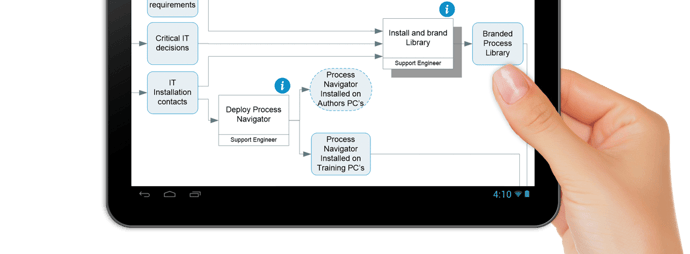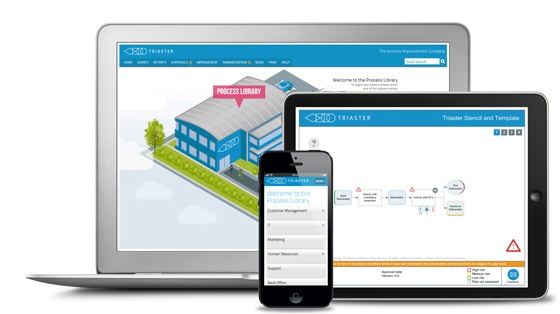Business Process Mapping is an extremely valuable skill to have because of the impact it has on process efficiency. However, there is a lot of information out there on process mapping techniques and not all of it is helpful or useful. I have taught many people how to process map and run process mapping workshops over the years and I have condensed this into a blog containing the best practices.
So let's get started shall we?
What is a Process?
What is a Process Map?

When mapping processes, we need to consider carefully the wording we are going to use. In order to tease out the salient information from the person doing the process mapping; at Triaster we recommend using open questions, starting with 'What?', 'Why?' and 'Who?' or even 'When'?
For example:
- What does this exercise produce?
- Why do you carry out that activity?
- Who is responsible for this task?
- When should this action be executed?
Imagine that an auditor is reviewing your organisation. Put yourself in their shoes. They are looking for you to say what you do and then crucially that you are doing what you say. A process needs to reflect what is done in practice.
For a more in-depth look at the fundamentals of process mapping, download our free process mapping report.
Optimising for Clear and Useful Outcomes
It may be useful when beginning a new process map, to be reminded that activities themselves have no value. They attract a cost. It is the output - the deliverable - that adds the value.
If someone is exceptionally busy all day, 'running themselves ragged', and yet is unable to specify an outcome from their exertions, it raises a big question mark over whether what they are doing is of value to their organisation. Similarly, if there is no value attached to an activity, how can it be improved or streamlined? How can the activity be altered to maximise a tangible benefit, whether it is related to financial value, time or otherwise?
When thinking about wording deliverables, we recommend asking: "What does this activity produce?" An 'updated system' may well be the case, yet it will not be clear which system is being updated, nor what the system has been updated with. You can then ask follow up questions by finding out "what happens with this deliverable as a result?" Does someone (or a program) in the organisation do something with it? Is this information forwarded on to anywhere? What purpose does it serve?
By using such questions, you can begin filling in the blanks. Thus for example, instead of an 'updated system' your deliverable can now read 'Sales order form A13 completed on Salesforce'. A well coined phrase at Triaster is 'garbage in, garbage out'. It helps to keep this in mind when facilitating or creating process maps. Results matter: who wants to hold their hand up to producing the unusable, or nonsensical?

Open Box, Box Open
In many instances, we review process maps that have activities containing phrases such as "Open box", with the subsequent output deliverable reading "Box open". In theory, this is not incorrect, as of course opening a box, results in an open box. However, by choosing your wording carefully when questioning the person delivering the process, you can produce process maps that are so much more useful, and useable and then they will be used.
Business Process Mapping Techniques - How to... / Show me the...
A further useful tip when facilitating process capture is to use the 'how to... / show me the...' test. It is a great way to check if your activities and deliverables are suitably described. When creating an activity or naming a map, we recommend silently or invisibly preceding its text with 'how to'.

When text makes sense when applying this test, you know you have a logical map or activity. As a further illustration on this, take the activity "Sales system updated with reference number". When we begin this activity with "how to": "how to Sales system updated with reference number", it does not make sense.
Change the words around slightly so that it reads "Update sales system with reference number" instead and precede the text with 'how to'. Its purpose as an activity is now crystal clear: "How to... Update sales system with reference number".

Using "show me the..." is also an excellent way of testing whether your chosen deliverable title is suitable. Just as we preceded the activity with 'how to...' you can use the same method for your deliverables. Precede them with 'show me the...' Let's take the deliverable "Sales system updated". Now precede this with 'show me the...'
Can you see how this does not make complete sense? By rearranging the text, you can use 'show me the...' to ensure this deliverable has a clear purpose. If its title reads "show me the... Updated sales system", you will immediately recognise the result, output (and purpose) of its preceding activity.
Clear as Mud - how obvious is your language?
We recommend avoiding ambiguous language by which I mean language that can be either interpreted as an activity or as a deliverable. What does complete agenda mean to you? How could your colleagues or customers interpret it? Do you "show the complete agenda" or is it something you are tasked with doing?
Wherever possible, encourage others in your organisation to avoid using acronyms. You may be surprised how many people outside the immediate scope of your process are unfamiliar with this form of short hand. Thus, SME could mean subject matter expert, specialist machine engineer, or small and medium enterprises and end up confusing the hell out of people.
A fast fundraiser for good causes (whether for the good of a team or external charities) is to have a tin, similar to a swear box in the office. Every time someone uses an acronym and they cannot explain its meaning, they should make a donation. It will soon mount up and acronym use will reduce.
We advise using purely alpha-numeric characters when creating maps, for two reasons. Firstly, certain characters have problems when published to HTML (such as the '&' symbol and the extended hyphen, both of which upset the navigation between maps (and other maps) and maps and menus. Also if a full stop is used, it suggests that there are two pieces of information or activities which need to be separated for clarity.
It also opens up the next question of how many spaces after a full stop. Depending on when you were taught to type, it may be one space or two. Language and punctuation are very powerful.
Consider these two definitions:
Without punctuation:
A panda that eats shoots and leaves
An animal with a varied diet.
This time with punctuation:
A panda that eats, shoots and leaves
An animal on the run, armed and dangerous, with their food bill left unpaid!
For a more in-depth report on process mapping, download our process mapping report and for an idea of how to get the best ROI from business process mapping software, take a look at our article on the subject.
Related Articles:
How to create a process map in 3 simple steps
Mapping business processes: What level should I map to?
What is the Noun-Verb methodology of process mapping?
The Top 10 Benefits of Process MappingWritten by Joel Evans
Joel joined Triaster in June 2014 and spent several years delivering consultancy and training services on site with customers, helping them to achieve many different business improvement objectives, in many different corners of the world. He left Triaster in November 2016 in order to move back closer to family.

